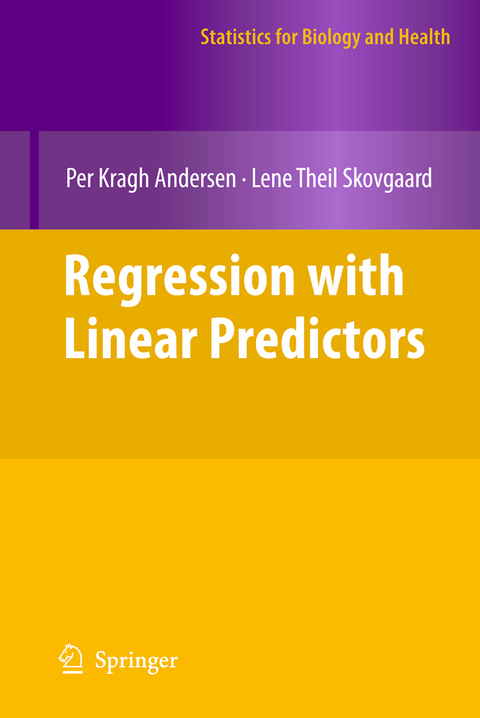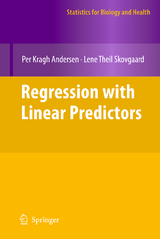Regression with Linear Predictors
Seiten
2010
Springer-Verlag New York Inc.
978-1-4419-7169-2 (ISBN)
Springer-Verlag New York Inc.
978-1-4419-7169-2 (ISBN)
This text provides a unified treatment of regression models for different outcome types, such as linear regression, logistic regression, and Cox regression. It includes many worked examples.
This is a book about regression analysis, that is, the situation in statistics where the distribution of a response (or outcome) variable is related to - planatory variables (or covariates). This is an extremely common situation in the application of statistical methods in many ?elds, andlinear regression,- gistic regression, and Cox proportional hazards regression are frequently used for quantitative, binary, and survival time outcome variables, respectively. Several books on these topics have appeared and for that reason one may well ask why we embark on writing still another book on regression. We have two main reasons for doing this: 1. First, we want to highlightsimilaritiesamonglinear,logistic,proportional hazards,andotherregressionmodelsthatincludealinearpredictor. These modelsareoftentreatedentirelyseparatelyintextsinspiteofthefactthat alloperationsonthemodelsdealingwiththelinearpredictorareprecisely the same, including handling of categorical and quantitative covariates, testing for linearity and studying interactions. 2. Second, we want to emphasize that, for any type of outcome variable, multiple regression models are composed of simple building blocks that areaddedtogetherinthelinearpredictor:thatis,t-tests,one-wayanalyses of variance and simple linear regressions for quantitative outcomes, 2×2, 2×(k+1) tables and simple logistic regressions for binary outcomes, and 2-and (k+1)-sample logrank testsand simple Cox regressionsfor survival data. Thishastwoconsequences. Allthesesimpleandwellknownmethods can be considered as special cases of the regression models. On the other hand, the e?ect of a single explanatory variable in a multiple regression model can be interpreted in a way similar to that obtained in the simple analysis, however, now valid only forthe other explanatory variables in the model “held ?xed”.
This is a book about regression analysis, that is, the situation in statistics where the distribution of a response (or outcome) variable is related to - planatory variables (or covariates). This is an extremely common situation in the application of statistical methods in many ?elds, andlinear regression,- gistic regression, and Cox proportional hazards regression are frequently used for quantitative, binary, and survival time outcome variables, respectively. Several books on these topics have appeared and for that reason one may well ask why we embark on writing still another book on regression. We have two main reasons for doing this: 1. First, we want to highlightsimilaritiesamonglinear,logistic,proportional hazards,andotherregressionmodelsthatincludealinearpredictor. These modelsareoftentreatedentirelyseparatelyintextsinspiteofthefactthat alloperationsonthemodelsdealingwiththelinearpredictorareprecisely the same, including handling of categorical and quantitative covariates, testing for linearity and studying interactions. 2. Second, we want to emphasize that, for any type of outcome variable, multiple regression models are composed of simple building blocks that areaddedtogetherinthelinearpredictor:thatis,t-tests,one-wayanalyses of variance and simple linear regressions for quantitative outcomes, 2×2, 2×(k+1) tables and simple logistic regressions for binary outcomes, and 2-and (k+1)-sample logrank testsand simple Cox regressionsfor survival data. Thishastwoconsequences. Allthesesimpleandwellknownmethods can be considered as special cases of the regression models. On the other hand, the e?ect of a single explanatory variable in a multiple regression model can be interpreted in a way similar to that obtained in the simple analysis, however, now valid only forthe other explanatory variables in the model “held ?xed”.
The authors are since 1978 affiliated with the Department of Biostatistics, University of Copenhagen. Per Kragh Andersen is professor; he is a co-author of the Springer book "Statistical Models Based on Counting Processes," and has served on editorial boards on several statistical journals. Lene Theil Skovgaard is associate professor; she has considerable experience as teacher and consultant, and has served on the editorial board of Biometrics.
Statistical models.- One categorical covariate.- One quantitative covariate.- Multiple regression, the linear predictor.- Model building: From purpose to conclusion.- Alternative outcome types and link functions.- Further topics.
| Erscheint lt. Verlag | 23.7.2010 |
|---|---|
| Reihe/Serie | Statistics for Biology and Health |
| Zusatzinfo | IX, 494 p. |
| Verlagsort | New York, NY |
| Sprache | englisch |
| Maße | 155 x 235 mm |
| Themenwelt | Mathematik / Informatik ► Mathematik ► Wahrscheinlichkeit / Kombinatorik |
| Studium ► Querschnittsbereiche ► Epidemiologie / Med. Biometrie | |
| ISBN-10 | 1-4419-7169-6 / 1441971696 |
| ISBN-13 | 978-1-4419-7169-2 / 9781441971692 |
| Zustand | Neuware |
| Informationen gemäß Produktsicherheitsverordnung (GPSR) | |
| Haben Sie eine Frage zum Produkt? |
Mehr entdecken
aus dem Bereich
aus dem Bereich
ein überfälliges Gespräch zu einer Pandemie, die nicht die letzte …
Buch | Hardcover (2024)
Ullstein Buchverlage
CHF 34,95




